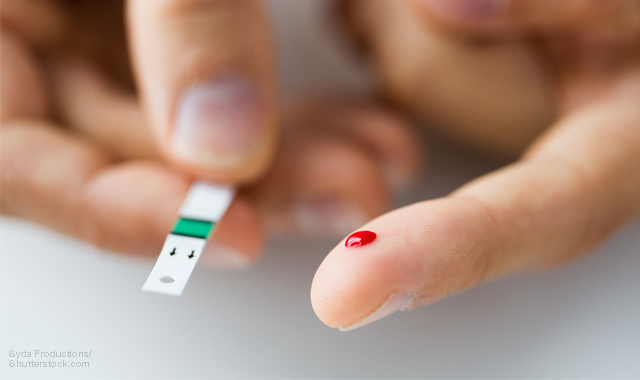Sustained DRSS improvement with aflibercept

Treating diabetic retinopathy (DR) with anti-vascular endothelial growth factor (VEGF) agents is an alternative to panretinal laser, and in some studies it has been found that “significantly more eyes with diabetic macular edema (DME)” can have a ≥ 2-step improvement in diabetic retinopathy severity scores (DRSS) than in eyes treated with laser, according to Rishi Singh, MD, who presented on the topic earlier this year at the American Society of Retina Specialists meeting.
But clinicians need to know the average time needed before patients can achieve a sustained DRSS improvement. Equally important is understanding the benefits of achieving the benchmark, he said.
Presenting on behalf of the VISTA and VIVID study investigators, Dr. Singh reported on a post-hoc analysis of the aflibercept studies that aimed to assess the time to and proportion of eyes with DME that achieved a sustained ≥1-step and ≥2-step improvement in DRSS score, and to evaluate the visual benefits of achieving a sustained ≥2-step improvement in DRSS score compared with a sustained ≥1-step worsening in DRSS score.
(To briefly recap, VISTA and VIVID were two randomized, multicenter, double-masked trials of patients with clinically significant DME with central involvement and a best-corrected visual acuity [BCVA] of 20/40 to 20/320. Patients were randomized to either intravitreal aflibercept every 4 weeks, every 8 weeks, or to laser, the latter of which served as the control arm. A total of 872 patients were enrolled: 291 to laser, 292 to aflibercept every 4 weeks, and 289 to aflibercept every 8 weeks.)
RELATED: Aflibercept injection approved for diabetic retinopathy
Post-hoc analysis
Eyes with a gradable baseline DRSS were included in the post-hoc analysis: 249 from the laser group, 250 from the aflibercept every 4 weeks group (2q4), and 249 from the aflibercept every 8 weeks group (2q8).
The rate of sustained ≥1-step and ≥2-step DRSS improvement was evaluated using the Kaplan-Meier method and log-rank test; for the purposes of this analysis, “sustained” was defined as improvement over at least 2 consecutive DRSS evaluation visits. Changes from baseline in BCVA and central subfield thickness were evaluated at weeks 52 and 100 in treatment groups for two DRSS subgroups - sustained ≥ 1-step worsening and sustained ≥ 2-step improvement. If patients received rescue therapy, data were censored from the time rescue treatment was given.
Baseline characteristics
The majority of patients in all three arms were in the low DRSS risk category: 108 (43.4%) in the laser group, 98 (38.4%) in the 2q4 group, 97 (39.0%) in the 2q8 group. However, almost twice as many patients were in the high DRSS risk category as in the moderate: 91 (36.5%) and 50 (20.1%) in the laser group, 110 (44%) and 44 (17.6%) in the 2q4 group, and 93 (37.3%) and 59 (23.7%) in the 2q8 group, respectively.
Post-hoc analyses outcomes
The cumulative incidence of sustained ≥ 1-step improvement from baseline to week 100 was 176 days in both aflibercept arms (P<0.0001). No patient was eligible in the laser arm.
“But does having a sustained improvement in DRSS lead to a better visual outcome?” Dr. Singh asked. In one case that illustrated a positive outcome, a patient improved from DRSS level 53 to 43 at week 52, coupled with a 17-letter gain on the ETDRS chart and a 236-micron reduction in central retinal subfield.
RELATED: SWAP-TWO shows anatomic improvement after switch to aflibercept
In the laser group, overall 24 patients had a ≥ 1-step worsening at both weeks 24 and 52, compared to just 9 with a ≥ 2-step improvement. Conversely, 25 patients in the two aflibercept groups showed a ≥ 1-step worsening while 70 showed a ≥2-step improvement. Similarly, the laser group saw a 3.2 letter gain when there was a ≥ 2-step improvement, but the aflibercept groups showed a 14.7-letter gain when there was a ≥ 2-step improvement. By week 100, however, the laser group showed an 11.3-letter gain from baseline when there was a ≥ 2-step improvement and the aflibercept groups showed a 15.4-letter gain when there was a ≥ 2-step improvement.
Overall, a higher proportion of eyes with DME treated with aflibercept achieved a sustained ≥1-step and ≥2-step improvement in DRSS score when compared to laser.
“A sustained ≥2-step DRSS improvement with aflibercept was associated with greater improvements in BCVA versus a sustained ≥1-step worsening,” Dr. Singh said, “which was only partly independent of a reduction in central subfield threshold.”
He added the findings “may help” clinicians in maintaining an optimal treatment strategy and in managing patient expectations.